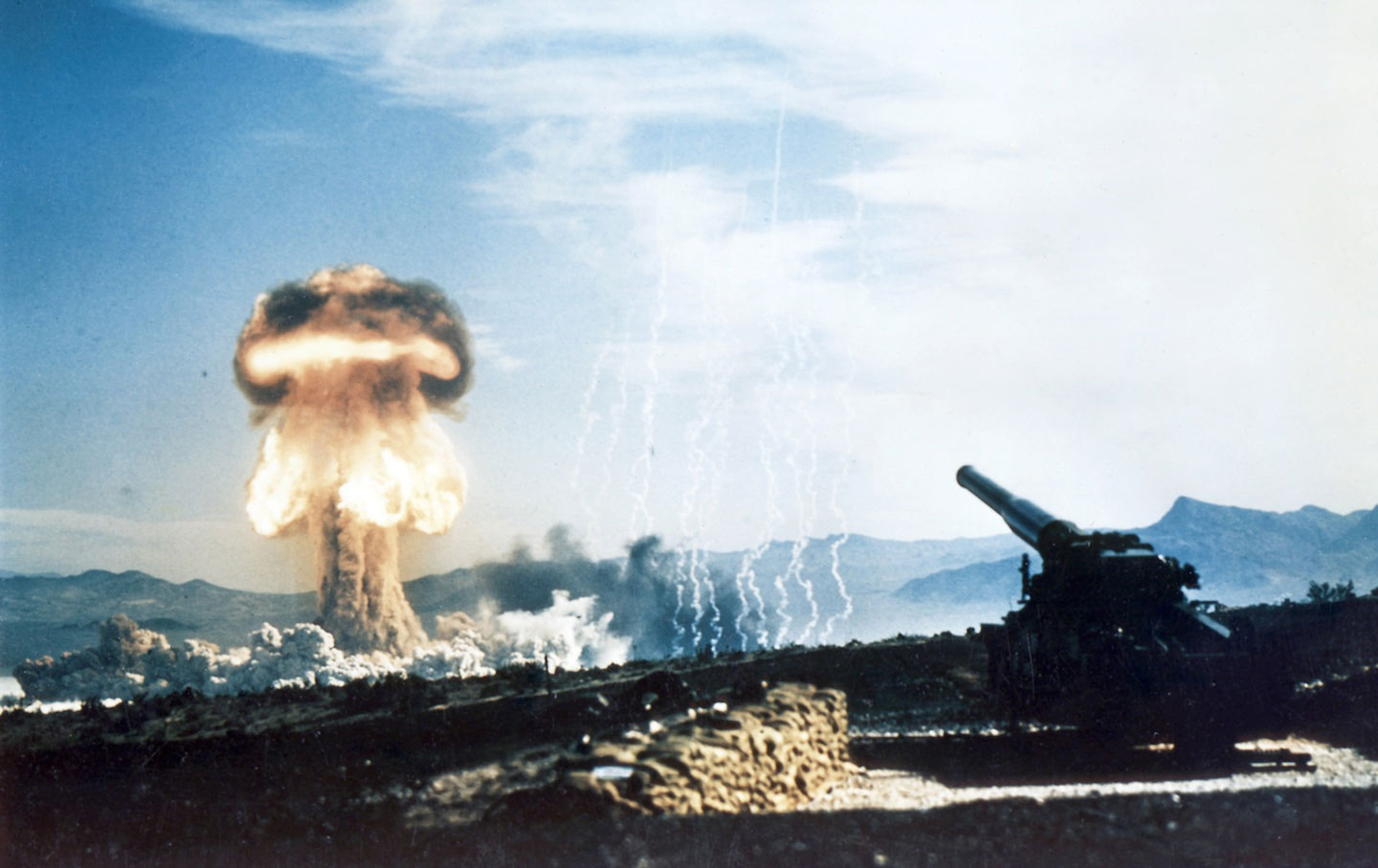The Nuclear Arms Race Never Ended
What passes for debate on Capitol Hill is routinely an exercise in assessing the most cost-effective outlays to facilitate Armageddon, not how to prevent it.

This article originally appeared at TomDispatch.com. To stay on top of important articles like these, sign up to receive the latest updates from TomDispatch.com.
Yes, the Doomsday Clock keeps ticking—it’s now at 90 seconds to midnight, according to the Bulletin of the Atomic Scientists—but the ultimate time bomb never gets the attention that it deserves. Even as the possibility of nuclear annihilation looms, this century’s many warning signs retain the status of Cassandras.
Presidents George W. Bush and Donald Trump withdrew the United States from vital pacts between the United States and Russia, the two nuclear superpowers, shutting down the Anti-Ballistic Missile, Open Skies, and Intermediate-Range Nuclear Forces treaties. And despite promising otherwise, Presidents Barack Obama and Joe Biden did nothing to revive them.
Under the buzzword “modernization,” the American government, a thermonuclear colossus, spent $51 billion last year alone updating and sustaining its nuclear arsenal, gaining profligate momentum in a process that’s set to continue for decades to come. “Modernizing and maintaining current nuclear warheads and infrastructure is estimated to cost $1.7 trillion through Fiscal Year 2046,” the office of Senator Edward Markey (D-Mass.) pointed out, “while the Congressional Budget Office anticipates that current nuclear modernization would cost $494 billion through Fiscal Year 2028.”
Such bloated sums might prove a good argument against specific weapons systems, but Uncle Sam has incredibly deep pockets for nuclear weaponry and a vast array of other military boondoggles. In fact, compared to the costs of deploying large numbers of troops, nuclear weapons can seem almost frugal. And consider the staggering price of a single aircraft carrier that went into service in 2017, the Gerald R. Ford: $13.3 billion.
Militarism’s overall mega-thievery from humanity has long been extreme, as President Dwight D. Eisenhower made clear in a 1953 speech:
Every gun that is made, every warship launched, every rocket fired signifies, in the final sense, a theft from those who hunger and are not fed, those who are cold and are not clothed. This world in arms is not spending money alone. It is spending the sweat of its laborers, the genius of its scientists, the hopes of its children.… This is not a way of life at all, in any true sense. Under the cloud of threatening war, it is humanity hanging from a cross of iron.
The Nuclear Complex and “Crackpot Realism”
In the case of budgets for nuclear arms, the huge price tags are—in the most absolute sense imaginable—markers for a sustained, systemic, headlong rush toward omnicide, the destruction of the human species. Meanwhile, what passes for debate on Capitol Hill is routinely an exercise in green-eyeshade discourse, assessing the most cost-effective outlays to facilitate Armageddon, rather than debating the wisdom of maintaining and escalating the nuclear arms race in the first place.
Take, for instance, the recent news on cost overruns for the ballyhooed Sentinel land-based missile system, on the drawing boards to replace the existing intercontinental ballistic missiles (ICBMs) in 400 underground silos located in Colorado, Montana, Nebraska, North Dakota, and Wyoming. Northrop Grumman has already pocketed a $13.3 billion contract to begin moving the project forward. But the costs have been zooming upward so fast as to set off alarm bells in Congress, forcing a reassessment.
“The US Air Force’s new intercontinental ballistic missile program is at risk of blowing past its initial $96 billion cost estimate by so much that the overruns may trigger a review on whether to terminate the project,” Bloomberg News reported in mid-December. Since then, the estimated overruns have only continued to soar. Last month, Northrop Grumman disclosed that the per-missile cost of the program had climbed by “at least 37 percent,” reaching $162 million—and, as Breaking Defense noted, Defense Secretary Lloyd Austin would need to “certify the program to stave off its cancellation.”
At one level, cancellation would vindicate the approach taken by disarmament-oriented groups a couple of years ago when they tried to stop the creation of the Sentinel by arguing that it would be a “money pit missile.” But at a deeper level, the cost argument—while potentially a winner for blocking the Sentinel—is a loser when it comes to reducing the dangers of nuclear war, which ICBMs uniquely boost as the land-based part of this nation’s nuclear triad.
As Daniel Ellsberg and I wrote in the Nation in 2021, “If reducing the dangers of nuclear war is a goal, the top priority should be to remove the triad’s ground-based leg—not modernize it.” Eliminating ICBMs would be a crucial step when it comes to decreasing those dangers, because “unlike the nuclear weapons on submarines or bombers, the land-based missiles are vulnerable to attack and could present the commander in chief with a sudden use-them-or-lose-them choice.” That’s why ICBMs are on hair-trigger alert and why defeating just the Sentinel would be a truly Pyrrhic victory if the purported need for such land-based missiles is reaffirmed in the process.
In theory, blocking the Sentinel by decrying it as too expensive could be a step toward shutting down ICBMs entirely. In practice, unfortunately, the cost argument has routinely led to an insistence that the current Minuteman III ICBMs could simply be upgraded and continue to serve just as well—only reinforcing the assumption that ICBMs are needed in the first place.
The author of the pathbreaking 2022 study “The Real Cost of ICBMs,” Emma Claire Foley, is now a colleague of mine at RootsAction.org, where she coordinates the Defuse Nuclear War coalition’s new campaign to eliminate ICBMs. “News of dramatic cost overruns on the Sentinel program is unsurprising, but I don’t think that in itself should encourage disarmament advocates,” she told me recently. “Cancellation of the Sentinel program does not equal a reduction in the number of nuclear weapons, or the risk of nuclear war. It will take an organized mass movement to make good on this opportunity to meaningfully reduce the risk of nuclear war.”
Popular
“swipe left below to view more authors”Swipe →The reemerging ICBM controversy is yet another high-stakes example of the kind of gauntlet that disarmament advocates regularly face in official Washington, where presenting an analysis grounded in sanity is almost certain to be viewed as “not realistic.” On the other hand, when it comes to nuclear issues, accommodating to “crackpot realism” is a precondition for being taken seriously by the movers and shakers on Capitol Hill and in the executive branch.
Such accommodation involves adjusting to a magnitude of systemic insanity almost beyond comprehension. Disarmament advocates are often confronted with a tacit choice between seeming unserious to the nuclear priesthood and its adherents or pushing for fairly minor adjustments in what Daniel Ellsberg, in the title of his final landmark book, dubbed all too accurately The Doomsday Machine.
This country’s anti-nuclear and disarmament groups have scant presence in the mainstream media. And the more forthright they are in directly challenging the government’s nonstop nuclear recklessness—with results that could include billions of deaths from “nuclear winter”—the less media access they’re apt to get. When President Biden reneged on his 2020 campaign pledge to adopt a no-first-use policy on nuclear weapons, for instance, critical blowback in the media was meager and fleeting. Little news coverage occurred when a small number of members of Congress went out of their way to object.
“Unfortunately,” Markey said in a speech on the Senate floor two years ago, “our American democracy and Russia’s autocracy do share one major thing in common: Both our systems give the United States and Russian presidents the godlike powers known as sole authority to end life on the planet as we know it by ordering a nuclear first strike.”
Nuclear Madness and Psychic Numbing
Any nuclear first strike would likely lead to a full-scale nuclear war. And the science is clear that a “nuclear winter” would indeed follow—in Ellsberg’s words, “killing harvests worldwide and starving to death nearly everyone on earth. It probably wouldn’t cause extinction. We’re so adaptable. Maybe 1 percent of our current population of 7.4 billion could survive, but 98 or 99 percent would not.”
Such a steep plunge in planetary temperatures would exceed the worst prognoses for the effects of climate change, even if in the other direction, temperature-wise. But leaders of the climate movement rarely even mention the capacity of nuclear arsenals to destroy the planet’s climate in a different way from global warming. That omission reflects the ongoing triumph of nuclear madness and the “psychic numbing” that accompanies it.
During the more than three-quarters of a century since August 1945, when the US government dropped atomic bombs on Hiroshima and Nagasaki, the nuclear genie has escaped from the bottle to eight other countries—Russia, France, the United Kingdom, China, Pakistan, India, Israel, and North Korea—all now brandishing their own ultimate weapons of mass destruction. And the biggest nuclear powers have continuously undermined the Treaty on the Non-Proliferation of Nuclear Weapons.
Key dynamics have scarcely changed since, in 2006, the Centre for International Governance Innovation published a cogent analysis that concluded: “Europe and North America are busy championing nuclear weapons as the ultimate security trump card and the preeminent emblem of political gravitas, thereby building a political/security context that is increasingly hostile to non-proliferation.”
Like Barack Obama before him, Joe Biden promised some much-needed changes in nuclear policies during his successful quest to win the White House, but once in office—as with Obama’s pledges—those encouraging vows turned out to be so much smoke. The administration’s long-awaited Nuclear Posture Review (NPR), issued in October 2022, was largely the usual dose of nuclear madness. “Although Joe Biden during his presidential election campaign spoke strongly in favor of adopting no-first-use and sole-purpose policies, the NPR explicitly rejects both for now,” the Federation of American Scientists lamented. “From an arms control and risk reduction perspective, the NPR is a disappointment. Previous efforts to reduce nuclear arsenals and the role that nuclear weapons play have been subdued by renewed strategic competition abroad and opposition from defense hawks at home.”
Stymied by the Biden administration and Congress, many organizations and activists working on nuclear-weapons issues were heartened by the blockbuster movie Oppenheimer, promoted from the outset as an epic thriller about “J. Robert Oppenheimer, the enigmatic man who must risk destroying the world in order to save it.” For several months before the film’s release last July, activists prepared to use it as a springboard for wider public discussion of nuclear weapons. The film did indeed make a big splash and sparked more public discussion of nukes in the United States than had occurred in perhaps decades. The movie had notably stunning production values. Unfortunately, its human values were less impressive, especially since people on the receiving end of the scientific brilliance at Los Alamos in Hiroshima and Nagasaki (and even downwinders in New Mexico) remained off-screen.
Watching the movie, I thought of my visit to the Los Alamos National Laboratory about 60 years after the triumphant Trinity atomic test. During an interview, one of the public relations specialists there explained that the legal entity managing the Los Alamos lab was “a limited liability corporation.” That seemed to sum up our government’s brazen lack of accountability for the nuclearization of our planet.
Six months after Oppenheimer arrived at multiplexes, its political impact appears to be close to zero. The film’s disturbing aspects plowed the ground, but—in the absence of a strong disarmament movement or effective leadership among officials in Washington on nuclear weapons issues—little seeding has taken place.
At the end of January, supporters marked the first anniversary of H. Res. 77, a bill sponsored by Representative Jim McGovern of Massachusetts and cosponsored by 42 other members of the House, “embracing the goals and provisions of the Treaty on the Prohibition of Nuclear Weapons.” The nonbinding measure aptly summarizes the world’s nuclear peril and offers valuable recommendations, beginning with a call for the United States to actively pursue and conclude “negotiations on a new, bilateral nuclear arms control and disarmament framework agreement with the Russian Federation” as well as purposeful talks “with China and other nuclear-armed states.”
Specific recommendations in the bill include: “renouncing the option of using nuclear weapons first; ending the President’s sole authority to launch a nuclear attack; taking the nuclear weapons of the United States off hair-trigger alert; and canceling the plan to replace the nuclear arsenal of the United States with modernized, enhanced weapons.”
The fact that only 10 percent of House members have even chosen to sponsor the resolution shows just how far we have to go to begin putting the brakes on a nuclear arms race that threatens to destroy—all too literally—everything.
More from The Nation

Celebrations in Syria May Be Premature Celebrations in Syria May Be Premature
The speed of the Assad dictatorship's collapse stunned even the opposition. But the result is a power vacuum that Israel and Turkey have already moved to occupy.

The Fall of Syria Changes Everything The Fall of Syria Changes Everything
Retired diplomat Chas Freeman and writer Pascal Lottaz discuss what happens now that Damascus is in the hands of Hayat Tahrir al-Sham.

Netanyahu Must Be Brought to Justice. But We Can’t Stop There. Netanyahu Must Be Brought to Justice. But We Can’t Stop There.
This genocide is a massive criminal undertaking, and we must hold as many of its perpetrators accountable as we can.

My Brother, Chef Mahmoud Almadhoun, Died Because He Fed Gaza’s Starving Citizens My Brother, Chef Mahmoud Almadhoun, Died Because He Fed Gaza’s Starving Citizens
His killing by Israel sent a chilling message that no one is safe, including humanitarians who stand in the way of Gaza’s erasure.

The Underground Network Helping Gazan Refugees Survive in Egypt The Underground Network Helping Gazan Refugees Survive in Egypt
A patchwork of volunteer-run mutual aid organizations has sprung up to tackle the severe problems facing people fleeing genocide.

The Dangers of Trump’s Foreign Policy The Dangers of Trump’s Foreign Policy
Strategic incoherence and factionalism reign.


